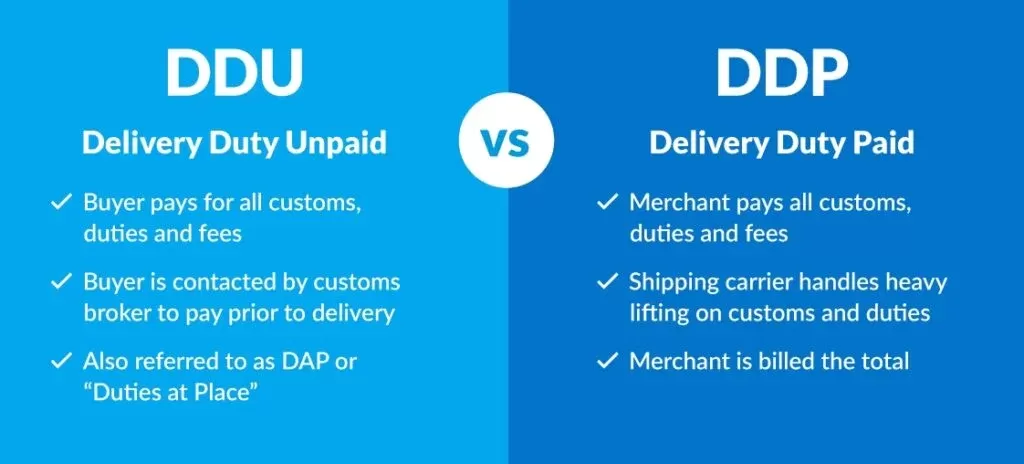Quick summary (one line): DAP (Delivered At Place) transfers import responsibility to the buyer; DDP (Delivered Duty Paid) makes the seller responsible for import formalities and all destination costs. Choose DAP when the buyer has local import capability; choose DDP when the buyer needs predictability and wants the seller (or an appointed IOR) to manage clearance and duty payment.
1) Short definitions — what each term actually means
DAP — Delivered At Place
Seller delivers the goods to the named place in the destination country, ready for unloading. Seller does not clear for import or pay duties/taxes. Buyer must perform import clearance and pay duties, taxes and any local charges.
DDP — Delivered Duty Paid
Seller delivers the goods to the named place in the destination country and also clears the goods for import and pays all duties, taxes, and import formalities. Buyer’s role is minimal at destination.
(Note: these are Incoterms rules — always confirm the agreed Incoterm (Incoterms® 2020) and the named place/location on the contract.)
2) Responsibility checklist — who pays / who does what
Below is a practical, non-exhaustive list of common cost and activity items and which party normally handles them under DAP vs DDP.
Export packing / origin loading
DAP: Seller → DDP: Seller
Main carriage (ocean/air)
DAP: Seller arranges → DDP: Seller arranges
Insurance (if agreed)
DAP: Seller arranges if CIF/CIP agreed, otherwise negotiable → DDP: Seller arranges or include in quote
Import customs clearance (entry filing)
DAP: Buyer → DDP: Seller
Duties & taxes
DAP: Buyer → DDP: Seller
Destination port/terminal fees, storage, demurrage (if unpaid)
DAP: Buyer → DDP: Seller
Last-mile drayage / carrier to consignee (if named place is consignee’s warehouse)
DAP: Buyer → DDP: Seller
Who gets the import documents (release, B/L, entry docs)
DAP: Buyer coordinates with broker → DDP: Seller or seller’s appointed IOR/EOR
Practical note: “Seller arranges main carriage” under DAP means the seller typically books transport to the destination place — but the seller does not handle import clearance unless otherwise agreed.
3) Decision flow—pick DAP or DDP (practical rule-of-thumb)
Do you (buyer) have a U.S. tax ID / local customs broker / ability to clear import and handle duties?
Yes, DAP can be cost-efficient if you can control clearance and avoid markups.
No → DDP is the safer choice.
Do you prefer cost-minimization at the expense of more admin? → DAP (if you have the capability).
Do you prefer predictable landed cost and minimal admin? → DDP (even if slightly higher price due to seller/IOR margin).
Are you shipping to Amazon FBA or a customer who requires scheduled delivery and pallet handling? → DDP + seller-arranged appointment or use DDP via a logistics partner who knows FBA processes.
4) Country-specific blockers & remedies (why DDP can be difficult)
Some countries require the importer to have local registrations (tax ID / VAT number / importer license). That prevents many sellers from performing DDP without a local presence.
Common remedies
Use an Importer of Record (IOR) or Employer of Record (EOR)—a third-party service that accepts legal import responsibility for a fee. TecEx-style IOR services solve DDP when sellers lack local registration.
Appoint a local customs broker with power of attorney (POA) — but POA alone does not substitute for local tax registration where required.
Limit DDP to selected lanes where the seller or its partner can practically and legally perform importation.
5) Worked on a landed-cost example—compare buyer cost under DAP vs DDP (real numbers)
This example shows the total cost a buyer pays under two commercial outcomes. Arithmetic is shown so you can reproduce it with your numbers.
Shipment assumptions
Quantity: 1,000 units
Unit price (factory): $5.00 → Goods value = 1,000 × 5.00 = $5,000.00
Ocean freight (FCL allocated to this shipment): $1,800.00
Insurance (all-risk at 0.5% of goods): 0.005 × 5,000 = $25.00
Customs broker & entry fee: $200.00
Import duty rate (example): 5% of goods value = 0.05 × 5,000 = $250.00
Drayage + last-mile: $600.00
Scenario A—DAP (buyer pays import costs)
Buyer pays: goods + freight + insurance + broker + duty + drayage.
Add step-by-step:
Goods = 5,000.00
Ocean freight = 5,000.00 + 1,800.00 = 6,800.00
Insurance = 6,800.00 + 25.00 = 6,825.00
Broker = 6,825.00 + 200.00 = 7,025.00
Duty = 7,025.00 + 250.00 = 7,275.00
Drayage = 7,275.00 + 600.00 = 7,875.00
Buyer total (DAP) = $7,875.00 → unit cost = $7.875 per unit
Scenario B—DDP (seller assumes import costs; seller charges a DDP service fee)
Assume the seller charges a packaged DDP service fee of $2,000.00 to cover import handling, duties, and margins.
Buyer pays: goods + freight + insurance + DDP service fee.
Add step-by-step:
-
Goods = 5,000.00
-
-
-
Interpretation
DDP often results in a higher all-in price because the seller charges for handling, cash flow (paying duties), and risk.
DAP may be cheaper on paper if the buyer can perform clearance and source low-cost local broker services — but DAP exposes the buyer to administrative tasks, timing risk, and potential unexpected fees.
Bottom line: Compare total landed cost (including hidden fees and staff time)—not just the base price.
6) Operational checklist—things to confirm before you accept DDP or DAP
Who will file ISF (or equivalent pre-arrival filing)? (Who submits & who keeps filing ID)
Who provides the commercial invoice & packing list in the exact format customs requires?
For DDP: confirm who pays duties at entry immediately (seller will pay—ensure seller’s cash flow or IOR arrangement).
For DAP: confirm broker name & contact at destination and agreed SLA for clearance.
If shipment to Amazon FBA: confirm delivery appointment process, pallet specs, and FBA label/ASN workflow.
Confirm currency and payment terms for duties and the DDP fee.
Clarify liability for demurrage/detention if release is delayed due to missing docs.
7) When DDP is worth the extra price (practical criteria)
Choose DDP when at least one of these applies:
Buyer lacks local import capability or time to manage import.
Goods are high-risk for delays (seasonal launches, retail deadlines).
Buyer prefers predictable per-unit landed cost and simple workflows.
Volume is small, and admin overhead for DAP would be disproportionate.
8) FAQs—quick answers buyers ask most often
Can sellers always offer DDP?
Not always. Legal and tax registration requirements in the destination country can prevent a seller from acting as an importer. Use IOR services where needed.
Does DDP shift tax liability?
Under DDP, the seller pays duties and taxes, but depending on local law, the buyer may still be treated as the importer for certain tax/legal reasons—verify with tax counsel.
Who handles returns under DDP?
Returns must be addressed in the contract. DDP covers original import; returns and re-export are separate and often cost additional fees.
Which term is better for Amazon FBA?
DDP is often easier for small sellers because it minimizes local admin and ensures the forwarder handles Amazon appointments. Confirm the forwarder has FBA delivery experience.
How to verify the duty amount in a DDP quote?
Ask for quotes to show the HS code used, the CIF value basis, the duty rate applied, and any taxes/fees included. Require quote validity and a recalculation clause if tariff changes occur.
Does DAP mean “seller pays ocean freight”?
Usually the seller arranges and pays for main carriage under DAP until the named place; however, import clearance and duties remain the buyer’s responsibility.
How do I avoid surprise fees under DAP?
Pre-agree on the destination broker, require an itemized estimate of expected duties/fees, and keep a contingency budget (10–20%) for unexpected charges.
Is there an official Incoterm change I should know?
Use Incoterms® 2020 language. Note that DAT (Delivered at Terminal) was renamed DPU (Delivered at Place Unloaded)—confirm you reference the correct 2020 term.

 EN
EN
 FR
FR
 ES
ES
 JA
JA
 PT
PT
 RU
RU
 AR
AR





